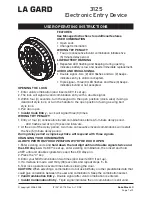
Chapter
3
31
Choosing Module Features
Because of the many types of ASCII devices available and the variety of
possible applications, you must configure your module according to the
ASCII device and specific application that you have chosen. To do this,
you must make some decisions. We will show you how to configure your
module using programming plugs and by setting bits in initialization
words.
Following the description of each module feature, we will show you how
to record your decision whether to use the feature, and when appropriate,
the quantity pertaining to the feature. At the end of this chapter, you will
consolidate your decisions on a worksheet. You can use the worksheet to
configure your module for your specific ASCII device and application.
This manual uses the following notation when referring to initialization
words and bits. There are four initialization words to configure your
module: IW1, IW2, IW3, and IW4. Bits within an initialization word are
shown in parentheses after the word. For example, bits 10 thru 17 in
initialization word three would appear as IW3(10-17).
The ASCII module responds to three modes of communication.
RS-232-C
Current Loop, 20mA
A-B Long Line
RS232C
Use this mode for communicating up to approximately 50 cable feet
between a printer or CRT and the ASCII module. The Electronics
Industry Association (EIA) standard RS-232-C sets data and control line
voltage levels for serial data communication. Data transmission is
negative true logic: -5 to -15Vdc for a logic 1, +5 to +15Vdc for a logic 0.
Control line commands are positive true logic: +5 to +15Vdc for enable,
-5 to -15Vdc for inhibit. The standard also specifies a 25-pin connector
and defines pin functions. Most systems use only the following pins:
Chapter Objectives
Choosing the Mode of
Communication
StockCheck.com
















































